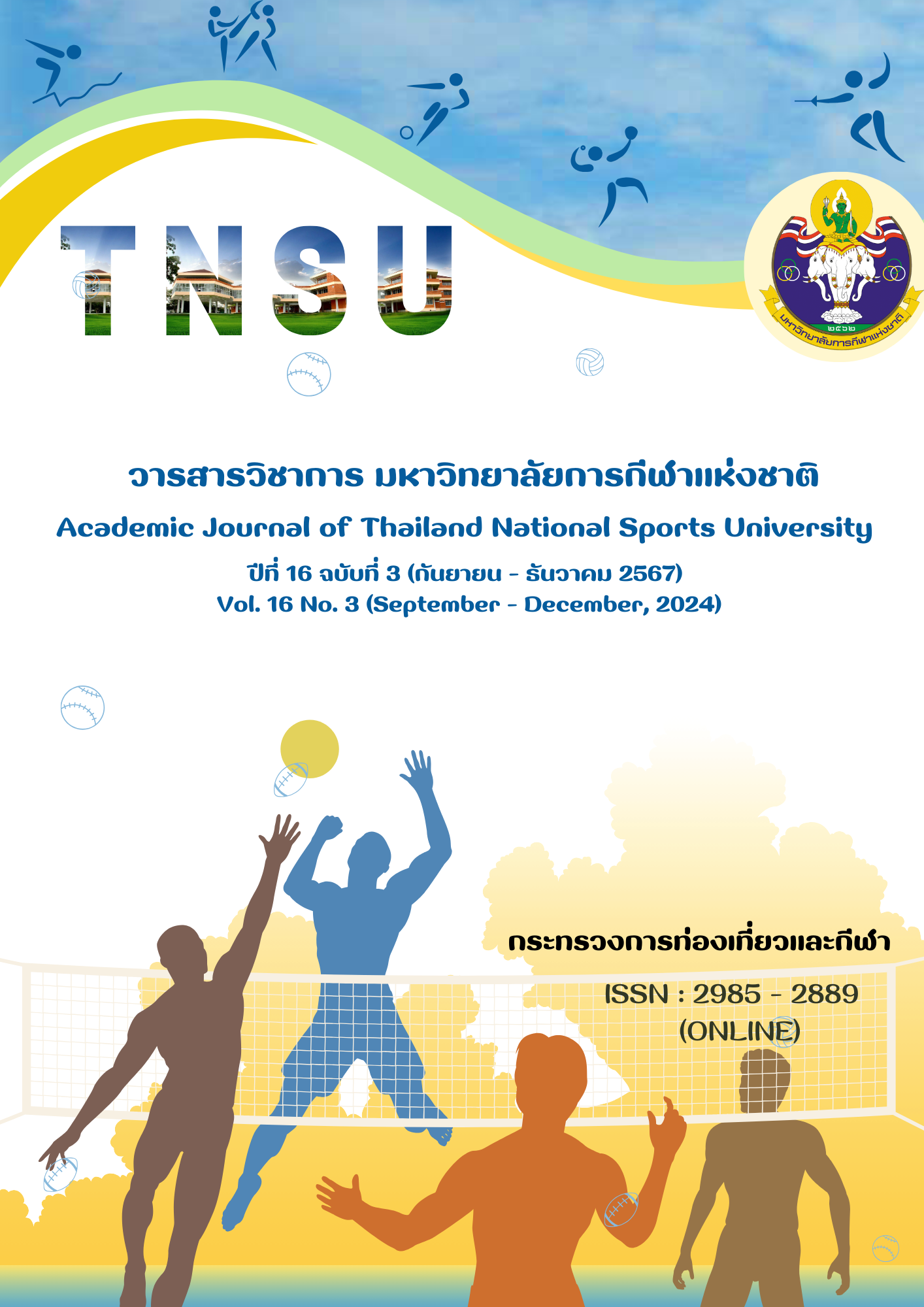EFFECT OF BALANCE BOARD TRAINING ON ANKLE STABILITY IN CHRONIC ANKLE SPRAIN ATHLETES
Main Article Content
Abstract
This research investigates the effects of balance board training on ankle stability among athletes with chronic ankle sprains. Fourteen athletes from a university in Mahasarakham province participated in the study, engaging in balance board training three days a week for eight weeks. Ankle stability was assessed using the star excursion balance test and balance test before training, and after training weeks 4 and 8. Data analysis included means, standard deviations, one-way analysis of variance with repeated measures, and multiple comparisons using LSD’s method, with an alpha level set at p < .05.
Results
- Ability to balance while moving. Between before training and after training weeks 4 and 8, it was found that stepping forward (Anterior) and stepping behind to the inside. (Posterolateral) and stepping outward from the back. (Posteromedial) are significantly different at the .05 level.
- Balance between before training and after training weeks 4 and 8 found that the open eyes and closed eyes were significantly different at the .05 level.
Article Details

This work is licensed under a Creative Commons Attribution-NonCommercial-NoDerivatives 4.0 International License.
The published article is a copyright of the Academic Journal of Thailand National Sports University. The passage appeared in each article in this academic journal is a perspective of each author which is not related to the journal. Each author is required to be responsible for all components of his/her own article. If there are any mistakes, each author must be responsible for those mistakes on his/her own.
References
Bastien, M., Moffet, H., Bouyer, L., Peroon, M., Hebert, L., & Leblond, J. (2014). Alternation in global motor strategy following posterolateral ankle sprain. BMC Musculoskeletal Disorders, 15(436), 1-12.
Bazyler, C. D., Beckham, G. K., Sato, K., & Mizuguchi, S. (2015). The efficacy of incorporating partial squats in maximal strength training. Journal of Strength and Conditioning Research, 29(12), 3493 - 3500.
Choisne, J., Hoch, M. C., Alexander, I., Ringleb, S. I., (2017). Effect of direct ligament repair and tenodesis reconstruction on simulated subtalar joint instability. Foot Ankle Int, 38, 324–330.
Cruz-Diaz, D., Lomas-Vega, R., Osuna-Pérez, M. C., Contreras, F. H., Martínez-Amat, A. (2015). Effects of 6 weeks of balance training on chronic ankle instability in athletes: A randomized controlled trial. Sports Med, 36, 754–760.
Domingo, C., Diego, I., Rueda, F. M., Lopez-Roman A., Fernandez-Carnero J. (2015). Effect of kinesiology tape on measurement of balance in subjects with chronic ankle instability: A randomized controlled trial. Arch Phys Med Rehabil, 96, 2169–2175.
Donovan, L., Hart, J., & Hertel, J. (2015). Effect of 2 destabilization devices on electromyography measures during functional exercises in individuals with chronic ankle instability. J Orthop Sports Phys Ther, 45(3), 220-232.
Gribble, A. P., Bleakey, C. M., Caulfield, B. M., Docherty, C. L., Fourchet, F., Fong, D. T., & Hiller, C. E. (2016). Evidence review for the 2016 international ankle consortium consensus statement on the prevennce, impact and long - term consequences of posterolateral ankle sprains. Br J Sports Med, 50(24), 1496-1505.
Gribble, A. P., Delahunt, E., Bleakley, C., Caulfield, B., Docherty, C., Fourchet, F., et al. (2013). Selection criteria for patients with chronic ankle instability in controlled research: A position statement of the international ankle consortium. J Orthop Sports Phys Ther 43(8), 585-591.
Gribble, A. P., Kelly, S.E., Refshauge, K. M., Hiller, C. E. (2013). Interrater reliability of the star excursion balance test. Journal of Athletic Training, 48(5), 621–626.
Gribble, P. A., Hertel, J., Plisky, P. J. (2016). Using the star excursion balance test to assess dynamic postural-control deficits and outcomes in lower extremity injury: A literature and systematic review. Journal of Athletic Training, 51(10), 942-950.
Kertanegara, I. P., Sudjana, P., Suprapto, H., & Wahab, A. (2016). The effect of balance training using a balance board on muscle strength development in isometric contractions. Journal of Strength and Conditioning Research, 30(9), 2593-2599.
Santani Khruekhon. (2005). Balance exercise results with a balance training board in people with unstable ankle work conditions. Department of Physical Therapy, Mahidol University.
Jirayut Leelanoiand, & Jirawat Khajornsilp. (2020). The results of archery balance with stability and accuracy archery recurve bow of male athletes institute of physical education chon buri campus. Academic Journal of Thailand National Sports University, 13(1), 189–199.
Maffulli, N., & Ferran, N. (2008). Management of acute and chronic ankle instability. J Am Acad Orthop Surg, 16, 608-615.
Mettler, A., Chinn, L., Saliba, S., Mckeon, P., & Hertel, J. (2015). Balance training and center of pressure location in participant with chronic ankle instability. J Athl Train, 50(4), 343-349.
Rendos, N., Jun, H., Feirman, K., Harriell, K., Lee, S. Y., Signorile, J. F. (2017). Acute effect of whole body vibration on balance in persons with and without chronic ankle instability. Research in Sports Medicine, 25(1), 91-102.
Shrier, I. (2017). Returning to play after injuries: A clinician's perspective. Clinical Journal of Sport Medicine, 27(4), 383-389.
Whitehead, P. N. (2017). Comparing measure of ankle proprioception, strength, and postural stability in male soccer players with and without chronic ankle instability as a result of non-contact Posterolateral ankle sprains (Doctoral dissertation), Retrieved from http://www.ohiolink.edu/etd/


